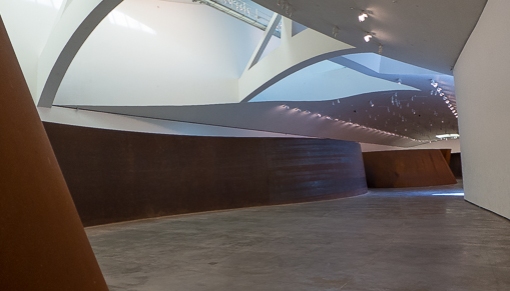While visiting Donostia-San Sebastián, we took a day-trip to see the incomparable Guggenheim museum in nearby Bilbao. The express bus route between the two cities is well-run, frequent and comfortable. Much of what we have written below came from the official web site.
A model of the building in the museum

When the Guggenheim Museum Bilbao opened to the public in 1997 after a 4-year construction period, it was immediately hailed as one of the world’s most spectacular Deconstructionist buildings. It will be celebrating its 20th birthday next year. Click here to see the official site.

On approach, one is greeted from a distance by Jeff Koon’s Puppy – a giant West Highland terrier carpeted in flowering plants. According to the official site, “Puppy employs the most saccharine of iconography—flowers and puppies … Koons designed this public sculpture to relentlessly entice, to create optimism,and to instill, in his own words, ‘confidence and security’ … as it stands guard at the museum, Puppy fills viewers with awe, and even joy.”

We had to agree that, especially on that somewhat cloudy date, it still made us feel positive.

The Solomon R. Guggenheim Foundation selected Frank Gehry as the architect. The curves on the exterior of the building were intended to appear random; the architect said that “the randomness of the curves are designed to catch the light”.

.

Located next to the Nervion River, the building uses primarily titanium, limestone and glass as the construction material.

It has been characterized by architectural critic as “a fantastic dream ship of undulating form in a cloak of titanium,” its brilliantly reflective panels also reminiscent of fish scales. Frank Gehry’s work has often been associated with the fish form – see our post on Gehry’s Berlin conference center – Axica here.

It is possible to walk all the way around the Museum, admiring different faces from each perspective and also a number of artworks installed outside.

One can’t miss Louise Bourgeoise’s Maman – a giant nine-metre-tall bronze, marble and stainless-steel spider, created in the 90’s.

The museum cost $89 million to build. The museum was opened as part of a revitalization effort for the city and it became a popular tourist attraction helping to generate millions spent on hotels, restaurants, and shops. The city collected taxes from tourist spendings which are more than what it paid for the building cost.

The interior “is designed around a large, light-filled atrium with views of Bilbao’s estuary and the surrounding hills of the Basque country”.

Inside the Hall, visitors access the atrium, the heart of the Museum with curved volumes and large glass curtain walls that connect the inside and the outside.

The atrium is flooded with light and covered by a great skylight. The three levels of the building are organized around it and are connected by means of curved walkways, titanium and glass elevators, and staircases.

See our next post on the artwork exhibited inside the museum.











 .
.
 Only Perfect Counts.
Only Perfect Counts.
 .
.



















































































 .
.
































































































































